

Python strings condensed. Code Style — The Hitchhiker's Guide to Python. If you ask Python programmers what they like most about Python, they will often cite its high readability.
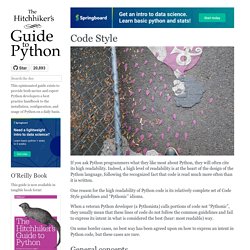
Indeed, a high level of readability is at the heart of the design of the Python language, following the recognized fact that code is read much more often than it is written. One reason for the high readability of Python code is its relatively complete set of Code Style guidelines and “Pythonic” idioms. When a veteran Python developer (a Pythonista) calls portions of code not “Pythonic”, they usually mean that these lines of code do not follow the common guidelines and fail to express its intent in what is considered the best (hear: most readable) way. On some border cases, no best way has been agreed upon on how to express an intent in Python code, but these cases are rare. General concepts Explicit code While any kind of black magic is possible with Python, the most explicit and straightforward manner is preferred. Bad def make_complex(*args): x, y = args return dict(**locals()) Good Note. How to be Pythonic and why you should care.
I’ve officially been writing code for over a dozen years now with the last 5 as a full-time software engineer, and while I still have MUCH to learn (a lifetime of learning to be exact!)

, I have seen my fair share of software and have (dare I say) developed my skills immensely in the field during that time. I still remember some of the first programs I ever wrote, and cringe in bed at night as I relive the nightmares of my days as a beginner programmer. While I will never escape the crimes of my past (writing quintuple-nested loops is the biggest of those sins), perhaps I can partially redeem myself, even if only slightly, by helping other developers who are fresh into the field learn a few best practices to write faster, cleaner, and better code. Why does all of this matter? This question is open to many interpretations, but a few key reasons why you should care come down to the clarity, efficiency, and credibility of the code. Clarity Does this code work? r04 python. Jupyter Notebook Tutorial: Introduction, Setup, and Walkthrough.
Python Tutorial: if __name__ == '__main__' String — Common string operations — Python 3.8.3 documentation. Format String Syntax The str.format() method and the Formatter class share the same syntax for format strings (although in the case of Formatter, subclasses can define their own format string syntax).
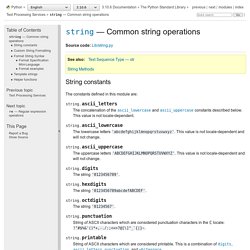
The syntax is related to that of formatted string literals, but there are differences. The grammar for a replacement field is as follows: In less formal terms, the replacement field can start with a field_name that specifies the object whose value is to be formatted and inserted into the output instead of the replacement field. The field_name is optionally followed by a conversion field, which is preceded by an exclamation point '! ' See also the Format Specification Mini-Language section.
The field_name itself begins with an arg_name that is either a number or a keyword. Changed in version 3.1: The positional argument specifiers can be omitted for str.format(), so '{} {}'.format(a, b) is equivalent to '{0} {1}'.format(a, b). Some simple format string examples: Python Variables, Constants and Literals. Python Variables A variable is a named location used to store data in the memory.
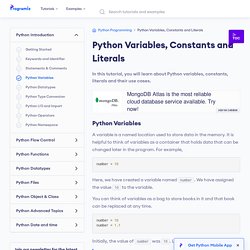
It is helpful to think of variables as a container that holds data that can be changed later in the program. For example, number = 10. Google Developers. Python has a built-in string class named "str" with many handy features (there is an older module named "string" which you should not use).

String literals can be enclosed by either double or single quotes, although single quotes are more commonly used. Backslash escapes work the usual way within both single and double quoted literals -- e.g. Strings in Python. Python Pandas Tutorial (Part 8): Grouping and Aggregating - Analyzing and Exploring Your Data. Python Pandas Tutorial (Part 8): Grouping and Aggregating - Analyzing and Exploring Your Data. Python Pandas Tutorial (Part 9): Cleaning Data - Casting Datatypes and Handling Missing Values.
The Zen Of Python Is A Joke And Here Is Why (You Should Not Take It Too Seriously) - DEV. The Zen of Python inspires programmers all over the world, but, it is not to be taken too literally.

The Venerable Zen, A Presentation typing this gives us. 13. Enumerate — Python Tips 0.1 documentation. Database Programming in Python. From a construction firm to a stock exchange, every organisation depends on large databases.

These are essentially collections of tables, and’ connected with each other through columns. These database systems support SQL, the Structured Query Language, which is used to create, access and manipulate the data. SQL is used to access data, and also to create and exploit the relationships between the stored data. Additionally, these databases support database normalisation rules for avoiding redundancy of data. Moodle. Parallel processing is a mode of operation where the task is executed simultaneously in multiple processors in the same computer.
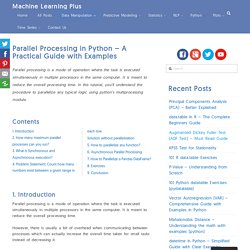
It is meant to reduce the overall processing time. In this tutorial, you’ll understand the procedure to parallelize any typical logic using python’s multiprocessing module. Contents. Expressions Tutorials & Notes. Python Expressions: Expressions are representations of value.
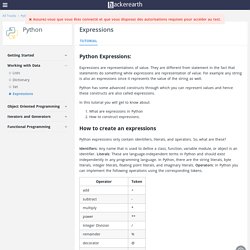
They are different from statement in the fact that statements do something while expressions are representation of value. For example any string is also an expressions since it represents the value of the string as well. Ray — Ray 0.8.0.dev7 documentation. Ray is a fast and simple framework for building and running distributed applications.
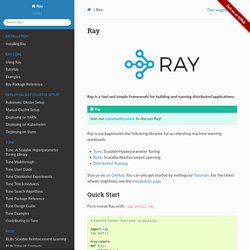
Ray is packaged with the following libraries for accelerating machine learning workloads: Quick Start¶ 10x Faster Parallel Python Without Python Multiprocessing. While Python’s multiprocessing library has been used successfully for a wide range of applications, in this blog post, we show that it falls short for several important classes of applications including numerical data processing, stateful computation, and computation with expensive initialization.
There are two main reasons: Inefficient handling of numerical data.Missing abstractions for stateful computation (i.e., an inability to share variables between separate “tasks”). Ray is a fast, simple framework for building and running distributed applications that addresses these issues. Get Started Tutorial for Python in Visual Studio Code. In this tutorial, you use Python 3 to create the simplest Python "Hello World" application in Visual Studio Code. By using the Python extension, you make VS Code into a great lightweight Python IDE (which you may find a productive alternative to PyCharm). This tutorial introduces you to VS Code as a Python environment, primarily how to edit, run, and debug code through the following tasks: The Python Ecosystem of 2017. Python is one of the most popular languages used in machine and deep learning. These two terms are sometimes used interchangeably but they are subtly different.
Before jumping into Python machine/deep learning libraries, let’s first define what these terms mean. Machine learning (ML) is a subset of Artificial Intelligence (AI) and is a process where a machine ‘learns’ to make predictions by recognizing patterns in large datasets. Modules and Packages - Learn Python - Free Interactive Python Tutorial. In programming, a module is a piece of software that has a specific functionality. For example, when building a ping pong game, one module would be responsible for the game logic, and another module would be responsible for drawing the game on the screen.
Each module is a different file, which can be edited separately. Writing modules. Python’s List Comprehensions: Uses and Advantages. Whether you’re a Data Scientist, a Web Developer working in an API, or any other of a long list of roles, chances are you’ll stumble upon Python at some point. Some of us love it for its simplicity, its fluidity and legibility. Others hate it for not being as performant as C or pure Assembly, having Duck Typing, or being single-threaded (ish). No matter what group you belong to, if you’re in a position where you want/have to write Python code, you’ll want it to be as legible as possible.
Or you may have stumbled upon a list comprehension in the wild and be confused as to how to tame it. Comprehensions in Python. Comprehensions in Python provide us with a short and concise way to construct new sequences (such as lists, set, dictionary etc.) using sequences which have been already defined. [] list comprehension — Python Reference (The Right Way) 0.1 documentation. Chapter 6 - Python Comprehensions — Python 101 1.0 documentation. Comprehensions — Python 3 Patterns, Recipes and Idioms. History: where did they come from? They require a mind shift. What makes them so compelling (once you ‘get it’)? Comprehensions are constructs that allow sequences to be built from other sequences. Python Comprehension Syntax. Tema 5: Definiciones de listas por comprensión. Nota: En este tema se usarán las siguientes librerías.
Python List Comprehensions: Explained Visually - Trey Hunner. Sometimes a programming design pattern becomes common enough to warrant its own special syntax. Python List Comprehension Tutorial. When doing data science, you might find yourself wanting to read lists of lists, filtering column names, removing vowels from a list or flattening a matrix. You can easily use a lambda function or a for loop; As you well know, there are multiple ways to go about this.
One other way to do this is by using list comprehensions. This tutorial will go over this last topic: Top 10 Python Libraries You Must Know In 2019. SQLAlchemy - The Database Toolkit for Python. Beautiful Soup: We called him Tortoise because he taught us. [ Download | Documentation | Hall of Fame | For enterprise | Source | Changelog | Discussion group | Zine ] You didn't write that awful page. You're just trying to get some data out of it. Nose-devs/nose. SymPy. 20 Python libraries you can’t live without – Python Tips. Hi there fellas. Today i am going to list 20 python libraries which have been a part of my toolbelt and should be a part of yours as well. Plotly/dash: Analytical Web Apps for Python & R. No JavaScript Required. Dash_simple_example_pandas_datareader.py. 17 Best Python Libraries - IssueHunt - Medium.
Python libraries and packages for Data Scientists (Top 5) 5. Data Structures — Python 3.8.0 documentation. Python Ecosystem for Machine Learning. 10 Visual Studio Code extensions for Python development. NilsJPWerner/autoDocstring: vscode extension that generates docstrings for python files. Setting up Visual Studio Code — Kedro 0.15.4 documentation. Vscode-restructuredtext/vscode-restructuredtext: reStructuredText Language Support in Visual Studio Code. Python. Google/python-fire: Python Fire is a library for automatically generating command line interfaces (CLIs) from absolutely any Python object. An introduction to parallel programming using Python's multiprocessing module.
Multiprocessing — Process-based parallelism — Python 3.9.0a1 documentation. How to do parallel programming in Python? Performance - How can you profile a Python script? 26.3. The Python Profilers — Python v3.2.6 documentation. 26.4. The Python Profilers — Python 2.7.17 documentation. Debugging and Profiling — Python 3.8.0 documentation. Optimization Tips for Python Code. Python Practices for Efficient Code: Performance, Memory, and Usability. Python Code Optimization Tips and Tricks You Should Know. Python Interpreter - Choose the Best to Execute Python Online. Optimizing Jupyter Notebook: Tips, Tricks, and nbextensions.
Python - Scientific Computing & Ipython Notebook: How to organize code? Python Lists and List Manipulation. Geometry Module — SymPy 1.3 documentation. The Best Python Data Visualization Libraries - FusionBrew - The FusionCharts Blog. 100 numpy exercises. 7 ways to improve your Python performance - Monitis Blog. Plotting Module — SymPy 1.3 documentation. Example Google Style Python Docstrings — napoleon 0.7 documentation. Python Exception Handling - ImportError and ModuleNotFoundError. 13. Enumerate — Python Tips 0.1 documentation.